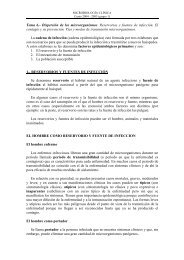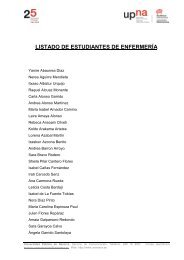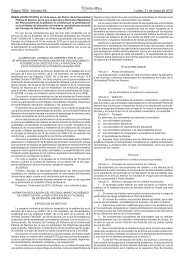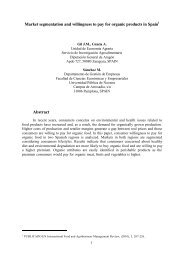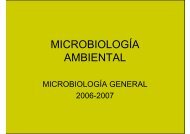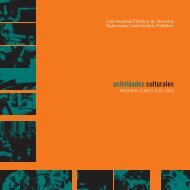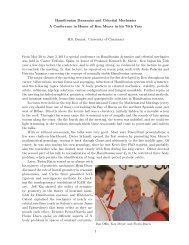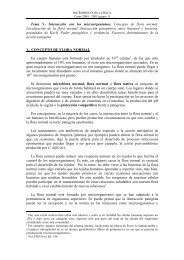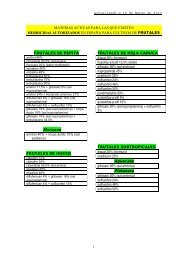Identification of Prosopis juliflora and Prosopis - Universidad Pública ...
Identification of Prosopis juliflora and Prosopis - Universidad Pública ...
Identification of Prosopis juliflora and Prosopis - Universidad Pública ...
You also want an ePaper? Increase the reach of your titles
YUMPU automatically turns print PDFs into web optimized ePapers that Google loves.
<strong>of</strong> pod coloration. Burkart (1976) noted P. affinis as native from Uruguay toParaguay. As the P. affinis identified in Brazil is probably P. pallida, it may alsobe assumed that the P. affinis identified in Peru by Ferreyra is also P. pallida,confirming the exclusion <strong>of</strong> this species from the P. <strong>juliflora</strong>–pallida complex byPasiecznik et al. (2001).Molecular markers have proven to be very useful tools in this study indifferentiating populations <strong>of</strong> the genus <strong>Prosopis</strong> at different taxonomic ranks.This study has allowed the identification <strong>and</strong> differentiation <strong>of</strong> the <strong>Prosopis</strong>species tested <strong>and</strong> has resolved the identity <strong>of</strong> introduced populations. This,<strong>and</strong> parallel studies using ploidy <strong>and</strong> leaf morphology (Harris et al. 2003), havehelped to resolve some <strong>of</strong> the outst<strong>and</strong>ing taxonomical problems <strong>and</strong> has aidedin the development <strong>of</strong> a practical field guide for the identification <strong>of</strong> tropical<strong>Prosopis</strong> species, <strong>and</strong> P. <strong>juliflora</strong> <strong>and</strong> P. pallida in particular (Pasiecznik et al.2004) for the benefit <strong>of</strong> foresters, farmers, extensionists, researchers <strong>and</strong>development workers worldwide.15AcknowledgementsThis work was supported by a grant from the Accio´n Integrada, H.B. 1999–0035 <strong>of</strong> the Spanish Ministerio de Educacio´n y Cultura.ReferencesAlban L., Matorel M., Romero J., Grados N., Cruz, G. <strong>and</strong> Felker P. 2002. Cloning <strong>of</strong> elite,multipurpose trees <strong>of</strong> the <strong>Prosopis</strong> <strong>juliflora</strong>/pallida complex in Piura, Peru. Agr<strong>of</strong>orest. Syst. 54:173–182.Burghardt A.D. <strong>and</strong> Palacios R.A. 1997. Electrophoretic characterisation <strong>of</strong> the American sections<strong>of</strong> <strong>Prosopis</strong> L. (Leguminosae: Mimosoideae). Bull. Int. Group Study Mimosoideae 20: 71–83.Burkart A. 1976. A monograph <strong>of</strong> the genus Posopis (Leguminosae subfam. Mimosoideae). (Part 1<strong>and</strong> 2). Catalogue <strong>of</strong> the recognised species <strong>of</strong> <strong>Prosopis</strong>. J. Arnold Arboretum 57: 219–249, 450–525.Church G.M. <strong>and</strong> Gilbert W. 1984. Genomic sequencing. Proc. Natl. Acad. Sci. 81: 1991–1995.Esbenshade H.W. 1980. Kiawe: a tree crop in Hawaii. Int. Tree Crops J. 1: 125–130.Felker P. 1990. <strong>Prosopis</strong> spp. In: Burns R.M. <strong>and</strong> Mosquera M. (eds), Useful Trees <strong>of</strong> TropicalNorth America. North American Forestry Commission Compendium Publication, No.3. USDAForest Service, Washington DC, USA pp. 85–96.Ferreyra R. 1987. Estudio sistémico de los algarrobos de la costa norte del Perú. Dirección deInvestigacio´n Forestal y de Fauna. Min. de Agricultura, Lima, Peru.Griffith A.L. 1961. Acacia <strong>and</strong> <strong>Prosopis</strong> in the Dry Forests <strong>of</strong> the Tropics. FAO, Rome, Italy.Harris P.J.C., Pasiecznik N.M., Bradbury M. <strong>and</strong> Ramírez L. 1998. Problems <strong>and</strong> potential <strong>of</strong><strong>Prosopis</strong>. In: Prendergast H.D.V., Etkin N.L., Harris D.R. <strong>and</strong> Houghton P.J. (eds), Plants forFood <strong>and</strong> Medicine. Royal Botanic Gardens, Kew, UK pp. 277–293.Harris P.J.C., Pasiecznik N.M., Smith S.J., Billington J. <strong>and</strong> Ramírez L. 2003. Differentiation <strong>of</strong><strong>Prosopis</strong> <strong>juliflora</strong> (Sw.) DC. <strong>and</strong> P. pallida (H. & B. ex. Willd.) H.B.K. using foliar characters <strong>and</strong>ploidy. Forest Ecol. Manage. 180: 153–164.Hunziker J.H., Poggio L., Naranjo C.A. <strong>and</strong> Palacios R.A. 1975. Cytogenetics <strong>of</strong> some species <strong>and</strong>natural hybrids in <strong>Prosopis</strong> (Leguminosae). Can. J. Genet. Cytol. 17: 253–262.






